Last updated: April 7, 2025
Article
New Contexts: Preservation Challenges of Modern Era Design
![Ann K. Dilcher, Quinn Evans Architects [Image links to a non-audio described video of this presentation.] Ann Dilcher stands at a lectern, presenting.](/articles/000/images/ncptt-mid-century-modern-Dilcher-video-screenshot.jpg?maxwidth=650&autorotate=false)
National Park Service
New Contexts for Mid-Century Modern Structures
I'm excited to come to this conference and I think a lot of what I have to present this morning really follows what we heard from Ghani this morning because my topic looks up some more case studies and some more questions.
I think some of the same questions and new questions.
And its really looking into these topics that we can discuss to day and over the next several days and we are continuing to discuss in our work on mid-century modern structures.
The examples of the work are mostly from the Michigan office of Quinn Evans, also looking a little bit of the DC work.
I'm going to talk about how we discuss and approach the mid-century modern problems and what we grappled with and working on these projects and then to ask questions for the discussion here in terms of what other people are looking at and wondering how they're solving their questions.
Topics: Eligibility, Adaptability, and Materials
All right, were looking at three different areas that we've been working on.
The first has to do with eligibility and documentation and understanding that where are we with the fifty year and exceptional significance or criteria G, and what are the considerations and questions that go along with that in mid-century modern structures.
Next, looking just a little bit about adaptability and what does it mean to adapt to mid-century modern structures. What about them makes it easier or harder to adapt, just looking at one small case study on that question.
And then also looking at material assembly as well and what are the materials involved in the specific materials conservation with the projects.

Ann K. Dilcher, Quinn Evans Architects
Lafayette Park: Detroit, Michigan
Starting out with a look at Lafayette Park which is in Detroit, Michigan.
We are working with the Michigan SHPO and this was in preparing a national historic landmark nomination.
The nomination is still in draft form but in the context, here are looking at urban renewal, modern architectural planning, and landscape design.
This project, really the significant stakes on it we have this from 1956 to 1957, the involvement of Reese Vanderough, Herbert Greenwald, his developer; Lidwig Simmer, his planner and Alfred Caldwell, his landscape architect to understand the importance of this as a land mark within Detroit.
Lots of the buildings here have already been listed individually.

Ann K. Dilcher, Quinn Evans Architects
Separate Historic from the Lost
And I think it's really part of this is to try and understand the questions the integrity of the national register and of our landmarking and understand where do we separate what we might call truly historic with what is merely old and those questions.
I think here is one that people are pretty clearly are really feeling is truly historic.
But, also it's that question of what came before and what was lost in that.
With the urban renewal movement and with the areas that were just completely scraped clean.
Is there a fabric or a history that we need to recognize, think about our comment on, hear the black bottom neighborhood, or thriving business that actually were what went away to build this landmark today?

Ann K. Dilcher, Quinn Evans Architects
Here's the images of it recently built.
This site has the townhouses.
It's very interesting on how the vehicular traffic has really kept in edges of the site.
And the overview gives you a sense of the super block concept that makes this so important with the integration of the landscape and the buildings.
Three towers and the townhouses, by standing in a row.
And this new idea of really concentrating your housing so that your also gaining the park and the landscape with the concentrated housing on it.
And just a couple more images recently of how it is today.
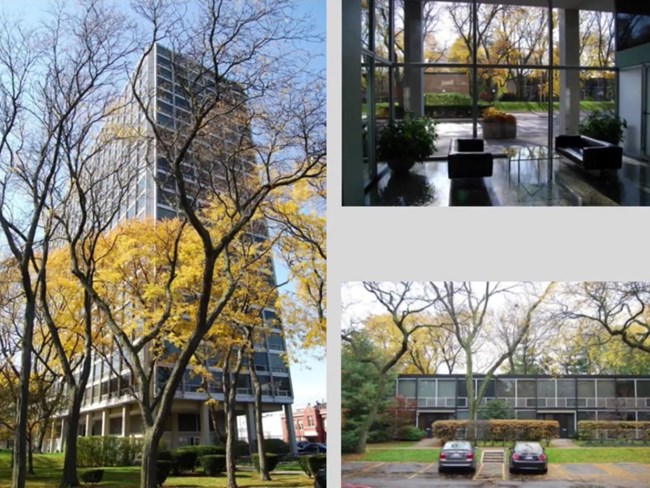
Ann K. Dilcher, Quinn Evans Architects
So look at this.
It's the last project in terms of the case study and materials in the work that we have done in the towers at the building.
But towers in some ways are similar with what we saw with Ghani with the plaza with the inside.
Outside curtain wall at that lobby and how you deal with the glazing on structures going up.
Fiberglas Tower, River View
Fiberglas Tower is also known as River View. This is another urban redevelopment project in Toledo.
It's one that we have recently nominated on the National Register now.
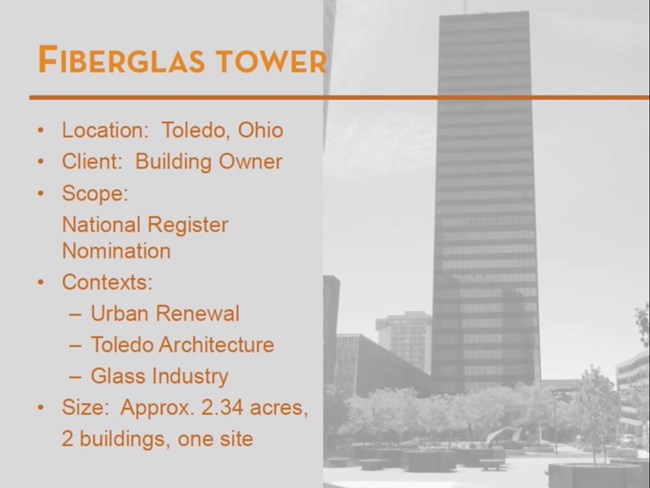
Ann K. Dilcher, Quinn Evans Architects
We determine it to be exceptionally significant locally.
It's the only urban renewal project that happened in downtown Toledo. It's the only part of a plan that was developed by [inaudible] that actually was completed here in terms of an urban renewal project.
And then, Harrison and Obramavitz from New York were the architects on the tower and parking garage.
This again, I think is interesting because its bringing in the urban landscapes and thinking about the urban landscapes as part of the mid-century modern landscapes with the plaza and the tower and the parking garage on here.
This the same team was sort of brought in to do this project who had just completed an [inaudible] project in Cleveland.
So it was the same planning and architectural team building off of that.
Here again, you see just the recognition of the fabric that was taken down and cleared.

Ann K. Dilcher, Quinn Evans Architects
In this case something was cleared, I think something was built.
I think its may be the history more in spots were actually the demolition from the urban renewal program was done and the funds were never there to build that we may have lost more.
Showing this as it recently opened parking garage is on the left and that tower is on the right.
It's Fiberglas Tower because it was done through Owen's Corner Fiberglas on that and the plaza has always been owned and maintained by the city.
So it was a project with several owners in it as it was completed.
And here's a view.
I think this is also an interesting one to talk about and to think about how we determine things significant or not, and the impact of those.

Ann K. Dilcher, Quinn Evans Architects
Because this tower has been vacant for many years and in part of it that is the importance of the tax credits that will go in and be used to make this a viable development project.
That's something in the Detroit, Toledo area that we look at.
A struggle with a lot [going] on.
Is it just merely old?
Or is it significant?
Or in deeming it really significant with the tax credit dollars?
Does that then allow us to leverage those and actually redevelop a site and start to redevelop a part of the city that might otherwise not get redeveloped?
And it's those sort of pressures that we look at and talk about.
So this is scheduled, hopefully to start design work on residential at the top of the building and office or residential down below.
I don't know if that's been decided yet.
It's originally all office.

Ann K. Dilcher, Quinn Evans Architects
FBI Headquarters
Next project is the FBI Headquarters.
I think this leads in some of the panel discussion later this afternoon of people thinking about old buildings and what buildings are loved or not loved from this era.
Let's say the important things here on this is the project that we brought in to look at the determination of the eligibility for this project for the GSA on it and in the end this was determined to not be eligible.
Project that was started in the '67 and not completed til '75.
So we are looking at the 50 year role.
We're looking at the uses of it were it was fairly obsolete when the building was built.
Already with physical file storage and finger printing and how it was set up that even by '75, the FBI and technology were changing so fast. So, what kind of a floor plate you have and what was the use.

Ann K. Dilcher, Quinn Evans Architects
It is named after J. Edgar Hoover which gives us a very prominent person. He did die before the completion of the building.
And then it's also: what's really important as part of this planning for the Pennsylvania Advisory Council plan along Pennsylvania Avenue where its located?
This shows you the double block it does occupy.
But throughout the process of this, it really seems the history seems that it was truly a building by committee, and committee and committee.
And I think there were some thoughts that really so much was compromised from what was the original designed and original part of the planning that was never realized in the project.
I think it one interesting case study because I think it brings up a lot of voices from both sides of the project. So here's the exterior and the interior courtyard view.
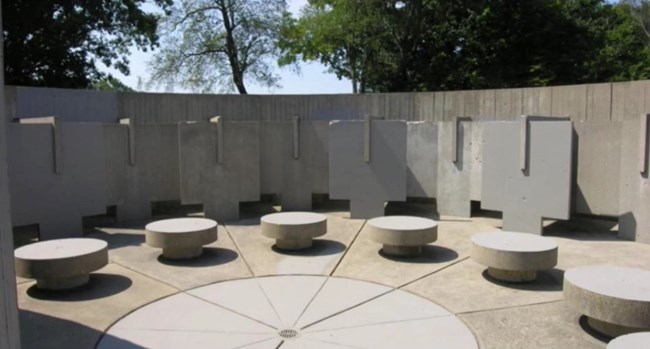
Ann K. Dilcher, Quinn Evans Architects
Bald Mountain State Recreation Area
Next, moving from a very big to a very small project.
This is at Bald Mountain State Recreation Area in Michigan, north of Detroit.
Mid-Century Modern Michigan.
You can come and be a tourist in Michigan and you can go visit this at a state park.
This is just a small bath house on a lake that was commissioned by the state parks.
It's designed by Gunnar Birkerts and Associates, a very important name in mid-century modern architecture and a very important name in Michigan modern, inspired by the Mission 66 and this has been listed on the National Register.

Ann K. Dilcher, Quinn Evans Architects
The question with this really is the idea of adaptability and here we move from we've determined its eligible but what and how can we use or reuse these buildings.
When you come to the park, this is your Contact Station.
This is were the person stayed and suppose to stay inside and then come out and get to the car, the wrong side of the car and just in terms of running a Park, it has never worked well.
But you can see what a whimsical and fun structure it is.
Once you get past this, another few miles on the road you come to the actual bath house complex.
It has two bath houses that have enclosed toilet room, open shower, changing room areas and a concession stand.
The concessionaire worked and you'd walk up and order your hot dog, your popsicle, what you needed.

Ann K. Dilcher, Quinn Evans Architects
So its just this fun design that in the 70s everyone went to the beach, laid on the beach, slathered up and it was towel to towel, but as recreation uses have changed, they get very few visitors here a year.
And structures while very interesting and unique in mid-century modernism are out in the park and are subjected to vandalism.
I do think it's interesting that the original drawings did call for brick, and this as an alternate on the drawings for the poured concrete. It think if they were brick, they might have crumbled sooner and not be here to be a question of how do you reuse as much for the parks.
So this is one of the bath houses. Here you see what you go in for a changing room. Again, it's an interesting architecture. It's a balance between what is the intent of the thought of the fun design versus the practicality of getting yourself between these little concrete walls. There's another little concrete stool to use to change within these cubbies. It's just not a friendly design for people.
So I was thinking about how we can find a new use. A building is something that's used. We need to find something here how can we make this work. It's not out on this park in Michigan. It's going to be hard to have it stay as a jewel of design with no use for it.
Here some photos from the site. And one of those are important and how do we keep them or not. The desks, the integrated light fixtures, the pie-shaped toilet stalls maybe not, that are concrete. But it's exciting- small but interesting problem on what to do and make this viable.

Ann K. Dilcher, Quinn Evans Architects
McGregor Center
Next, looking at the McGregor Center which is in Michigan.
This is sort of going more to the materials and what are the questions with the materials.
This is at Wayne State University its the reflecting pools and site restoration that we're involved in.
You can come [inaudible] where the crowd is getting an award there at it.
This a historic photo and I think here the important thing is to understand it's a black and white photo but to understand the black and white of it.
The black of the reflecting pool and the white of those islands and walkways. It was really an important part of the original design.
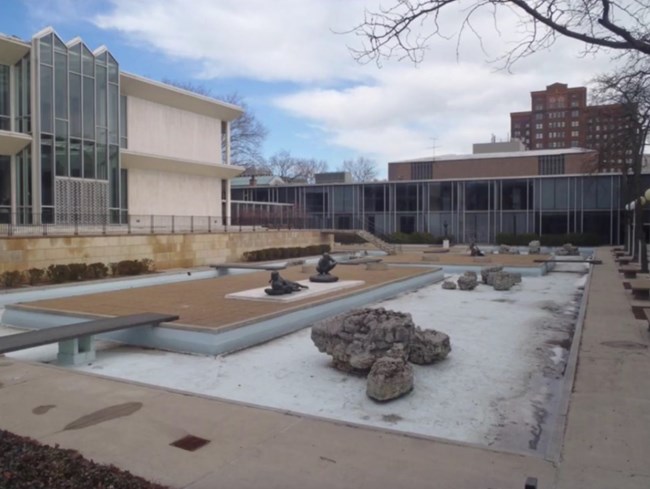
Ann K. Dilcher, Quinn Evans Architects
When we got there on the project, this is what it looked like.
The pools had always leaked.
This is the Yamasaki project, I forgot to note. For those who don't know it...it's very important. We are working on landmarking this building and the site.
It was important as one of his first reflecting pool designs that he went on to do more work on.
But it had leaked often.
Those beautiful white islands were chipped marble that everyone kicked in to the pool.
They gummed up the works even more.
But its that clean look with that plastic...boulders that were picked and selected.

Ann K. Dilcher, Quinn Evans Architects
More and more our work involves laser scanning the projects before we start to really understand it.
It helps us understand the problems and it understands how to document where things get put back.
Part of the importance of this scan, was those boulders and we want things to go back where they were, and how they were placed by Yamasaki when the project was initially created.
What we found out though was as we started the project, the concrete of the pool was dissolved. It was not a material that we could keep and restore.
And so then the fourth of this laser scan was very important because this project was a complete recreation of the pools. So it's there looking at is the concrete of the pool that's important or is it the intent, and the design intent of the project.
And this project, it was really the design intent that we felt was the most important to bring back.
So much of this is a complete recreation but its going back to the white look.
This time the marble chips are adhere into the pavers so that it should stay and function well. It's going back to the black look of the pools and reflecting and making this a very wonderful serene space to be in and enjoy. It's just a wonderful spot on the campus, if anyone's in Detroit.

Ann K. Dilcher, Quinn Evans Architects
Lafayette Towers
And finally, look at Lafayette Towers.
We started looking at Lafayette Park. Here the building owner asked us to look at the plaza restoration, window restoration.
We also did a complete MAPU replacement in these buildings.
There are the two towers with the parking garage between on Lafayette Park.
A later muse project where I think he worked out a lot of the details from his earlier projects and how to execute them here.
The coverings up into the materials and that looking at the aluminum.
And what kind of mockups do we got do to try and understand how to clean in this case the aluminum.
And the different options you're studying and testing to try and understand what works best on these mid-century modern structures.
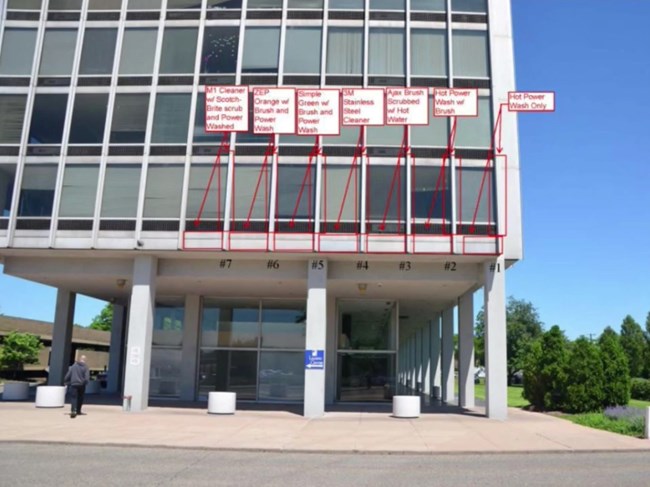
Ann K. Dilcher, Quinn Evans Architects
And then it was also a question of the windows, and doing an energy replacement you are asked to looked at the windows and shouldn't you replace the windows and what can happen.
In this case, we deem that it really wasn't to keep the look, it really wasn't possible to replace the windows.
And the windows were not that bad condition.
It did involve abating around every window where we had to abate and reseal every window but keeping the original fabric on these buildings.
And the very last kind among this project in my presentation is looking at the plaza.
In this I think is a plaza where it's sort of the opposite take of Yamasaki's reflecting pools.
In here, it was looking at not the design intent, the aesthetic intent of the plaza but looking what is the functional intent of this plaza.

Ann K. Dilcher, Quinn Evans Architects
This was a plaza meant for people to come and gather and recreate and have the pool here.
The plaza was leaking, the other picture of concrete spalling on the cars below.
So it was the complete replacement of the plaza and the plaza's system.
And in here, there were a lot of discussions and it was really decided that it was the intent of the plaza as a place to gather.
And that it would be redone with the pool and with some of the significant features, but rebuilt very differently with a lot more green space and different areas to try and give people what they want to use today: to come and enliven the space and to gather how people do today not in the past.
So this is hard to see the plan but a lot more of the green roof in it.
Looking at where we could putting curves to signify and have ghosts of what the original had been but really its bringing a lot more green space and opportunities for some other activities that they don't have on the plan.
This presentation is part of the Mid-Century Modern Structures: Materials and Preservation Symposium, April 14-16, 2015, St. Louis, Missouri. Visit the National Center for Preservation Technology and Training to learn more about topics in preservation technology.
